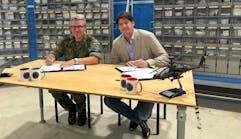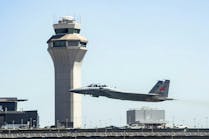Top U.S. defense contractors are competing for billions of dollars of work tied to the next big technology focus in national-security circles: hypersonic weapons.
The military’s renewed interest in ultra-high-speed missiles — spurred by concern that the U.S. is lagging Russia and China — opens the door to lucrative contracts that could last decades. That may provide a much-needed boon for manufacturers seeking to capitalize on growth segments as the Biden administration keeps overall defense outlays in check.
The industry is developing an array of the super-high speed armaments for the U.S. Army, Navy and Air Force, with the aim of being able to launch them from planes, submarines and trucks. Lockheed Martin Corp. has the leading position in key programs that aim to deliver prototypes the soonest — with flight tests on a new missile slated for the first half of next year. Raytheon Technologies Corp. and Northrop Grumman Corp. are also seeking to get a toehold in the market for missiles that fly at more than five times the speed of sound.
“It’s all about making sure that we have more and more capability and classes of capability in hypersonic weapons,” said Jay Pitman, the vice president of air dominance and strike weapons at Lockheed’s missiles and fire control division. “That will enhance the strategic deterrence that we are able to provide.”
Pentagon officials recently estimated that Army and Navy programs that share a common missile may alone add a combined $28.5 billion to the services’ budgets over the coming years.
Critics question the price tag, technical feasibility and battlefield utility of the new class of military hardware. The Union of Concerned Scientists has cast doubt on claims that the weapons offer better performance than existing ballistic missiles and has warned of a destabilizing global arms race.
The pursuit of the weapons by strategic rivals in some ways evokes the tensions of the Cold War, when fears abounded that a conflict between the U.S. and Soviet Union could bring about global annihilation via nuclear missiles. It also was a lucrative epoch for defense contractors.
But just how much hypersonic weapons will alter the global balance of power remains a matter of debate. Some observers see a risk that the weapons’ high speed and unpredictable flight paths could lead to miscalculations that may escalate conflicts, according to the nonpartisan Congressional Research Service. Others argue that hypersonic weapons do little to alter the dynamic between the U.S., Russia and China, because the countries already have enough nuclear missiles to overwhelm an enemy’s defenses, the group said.
Flying at speeds topping 3,800 miles (6,100 kilometers) per hour is nothing new — ballistic missiles exceed that level when they reenter the Earth’s atmosphere from space. But these next-generation weapons are designed to be highly maneuverable at those velocities within the Earth’s atmosphere, helping them evade traditional defenses better than ballistic missiles that travel along a predictable arc.
The U.S. has been studying hypersonic weapons for decades, but spending has jumped in recent years as interest in the technology soared. The topic came into focus when Gen. Mark Milley, chairman of the Joint Chiefs of Staff, said in an October interview on Bloomberg TV that a recent hypersonic test by China was close to a “Sputnik moment” for the U.S.
U.S. military officials have confirmed the Asian nation recently tested a hypersonic weapon that traveled around the world and hit a target back in China.
President Vladimir Putin has boasted about Russia’s hypersonic capabilities after showing them off in 2018, though the U.S. has been more vocal about concerns over China’s program.
Until the technology progresses, it’s unclear precisely how big a boon it will be for top U.S. defense contractors. Beyond near-term plans to deliver hypersonic weapons through a handful of development programs, Pentagon officials have made few decisions about how many and what type of weapons they plan to pursue longer term.
“We’re still waiting on the Department of Defense to define where this fits in their portfolio,” said Wesley Kremer, president of Raytheon Missiles & Defense.
Lockheed Martin is the prime contractor for a hypersonic boost-glide missile for the U.S. Army and Navy, which also are sharing flight test plans to help speed development.
Lockheed’s Eric Scherff, vice president of the space systems division overseeing the program, said the company plans an initial flight test in the first half of 2022 and its first hypersonic missiles are on track to be delivered to the Army by the end of the government’s 2023 fiscal year. The Bethesda, Maryland-based defense giant is working on six hypersonic programs for the U.S. that could enter production between 2023 and 2026, Chief Executive Officer Jim Taiclet said told analysts in October.
Annual revenue tied to hypersonic weapons should rise to $3 billion by 2026 from $1.5 billion today, assuming key programs reach production, acting Chief Financial Officer John Mollard said during the same conference call.
Northrop Grumman supplies the missile’s rocket motors while Leidos Holdings Inc.’s Dynetics subsidiary is making the hypersonic glide body. Dynetics has a $342 million contract to produce 14 gliders, which could lead to a deal to produce 124 worth some $1 billion in revenue, according to the company.
After launch, the missile deploys a wedge-shaped glider when it’s above the atmosphere that enables it to zoom toward a target at ultra-high speeds.
Raytheon and Northrop Grumman successfully test-fired an air-breathing concept weapon in September, part of a $200 million contract. The test “went a long way to demonstrating how far and how fast we’ve been able to mature that technology,” said Raytheon’s Kremer.
The aircraft-launched hypersonic weapon uses a rocket booster to accelerate beyond the sound barrier before a supersonic ramjet — or scramjet — engine kicks in to propel the weapon past Mach 5. This type of missile could be purchased in larger quantities than boost-glide systems and at a lower unit cost, Kremer said.
The Pentagon’s rapid development effort has also seen some stumbles. Lockheed’s air-launched hypersonic weapon under development for the Air Force has failed three tests since April, most recently on Dec. 15.
As high-tech as this new generation of hardware sounds, it may be just a prelude to what contractors’ secretive research-and-development operations hint they could pursue next: a jump to light speed.
“Hypersonic technology is the natural evolution on the path to where we’ll eventually go, which is to speed-of-light weapons,” Kremer said.
___
©2021 Bloomberg L.P. Visit bloomberg.com. Distributed by Tribune Content Agency, LLC.


